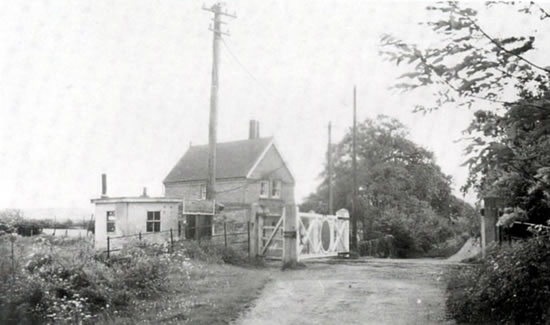Courtesy of Brian Hart. This wonderful though blurry image appears to have been taken from the top of a signal early in the twentieth century. Perhaps the gate keeper and his wife are pictured here? Behind the coal trucks in the siding can be seen the gate keepers cottage. It is rare to see an image of the siding when the ballast was fresh and before weeds had grown up.
Courtesy of Brian Hart. A view of Churn Lane siding looking towards Horsmonden soon after a train had smashed through the gates (the ropes had to act as temporary gates before their repair). On the left a mile post shows that the crossing was thirty-seven and a half miles from London Charing Cross.
Courtesy of Brian Hart. Looking towards Horsmonden again but from the end of the sidings, as the line began its mile long climb at 1 in 66 up to Horsmonden Tunnel. I believe that the warning bell on the telegraph pole was added following the above mentioned accident to help warn the gate keeper that a train was coming.
Courtesy of Brian Hart. Taken from the lane. A crossing keeper watches from his box as a train rumbles towards Paddock Wood. This sturdy shed appears to have stood for many years before finally being replaced by a small prefabricated structure not long before closure.

Courtesy of Brian Hart. Looking in the direction of Paddock Wood towards Churn Lane and the keepers cottage from the siding itself.
Looking down Churn Lane one bright evening. The railway once crossed the road diagonally from the opening in the hedge on the right hand side to further down the road near to the house on the left.
To the north the track curved round on the right hand side of the above field towards August Pitts Farm (now known as 'Beechland'), Old Hay Farm, Willow Lane and then Paddock Wood Station about 2.68 miles north, Charing Cross was 37.5 miles from here.. At this point the line had been climbing at 1 in 78 (from 1 in 1,000 before that) but now in Horsmonden parish the Wealden hills begin.
The level crossing keepers house still stands although the gates are long gone (I have a very vague memory of seeing them as a small boy). This is another red brick house with its distinctive downstairs bay window and a finial on the roof.
As stated, up to Churn Crossing the line climbed at 1 in 78 but this increased to 1 in 66 soon after crossing the road, for a mile until Horsmonden Tunnel. The old steam locomotives that were allocated to work the line sometimes struggled to make the climb up especially if the rails were icy or if pulling heavy loads like hop pickers' specials. One broke down in Horsmonden Tunnel once and the fireman had to walk along the track to Horsmonden Station so that they could phone Tonbridge for another locomotive to assist. The sidings were perhaps badly sited due to the rate of incline (1 in 78 one end and 1 in 66 the other) it was preferable to leave trucks at the northern end as they were less likely to roll.
Eh, looking towards Yew Tree Green Road and Horsmonden (the new fence obscures the view but the direction of the track bed can be seen from Google maps. Beyond the fence, sidings were added after the line opened. The SER were taken aback by the amount of goods traffic when the line opened and were obliged to add these sidings. These were used regularly until 1940 after which their use declined, presumably the trend to move goods traffic onto our roads had already began by then.




















































